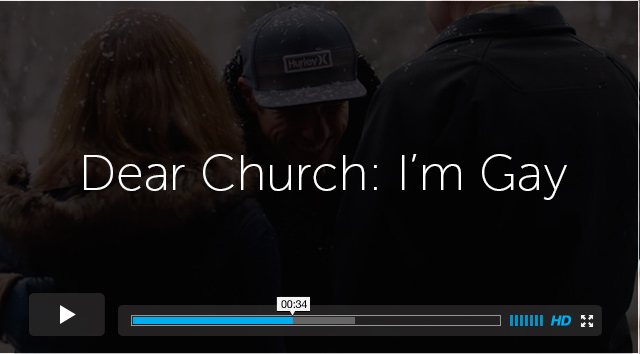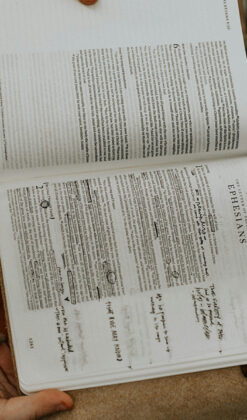It is ironic and possibly prophetic that the Nashville Statement (NS) was published the very same day that I released a short film on LGBT people in the church titled Dear Church: I’m Gay. I think these two “statements” represent two brands of evangelical approaches to questions about faith, sexuality & gender. These two brands overlap quite a bit; they both agree that marriage is between a man and a woman and that all sexual relations outside this type of marriage covenant are sin. That’s a big overlap. However, there are many differences in tone, rhetoric, and how to go about this whole conversation. In some ways, the Nashville Statement brought these differences to light.
Let me dive in with some pros and cons regarding this statement after I make two quick caveats. First, I was not aware of the NS until about 3 days after it was published. I wasn’t asked to participate in its formation, nor did anyone on the list let me know that such a thing was happening. While I find some things positive with the statement, I have not and will not sign the NS. I’ll explain why below.
Second, everything I say below are my personal reflections and do not represent The Center for Faith, Sexuality & Gender as a whole. At The Center, we want to foster healthy diversity within a historically Christian perspective on marriage and sexuality. I’ve told my board members and other collaborators that they are completely free to form their own thoughts on the NS. In fact, several people who have signed the NS have also endorsed me or The Center’s work, and I’m eternally grateful for their gracious remarks. In the near future, The Center will probably release a more formal statement of where we stand in relation to the NS. Until then, here are some personal thoughts. Let’s start with the positives.
Pros
I admire the authors’ passion to uphold a historically Christian view of marriage and gender. And again, I’m in agreement with the general conclusion about marriage expressed in the document. I would consider myself just as passionate about an orthodox view of marriage and gender as they are, and I do think that Christians who affirm same-sex marriage and deny the biological link between sex and gender are at odds with some very basic tenets of a Christian worldview. (I just don’t think this statement the best way to go about this whole discussion.)
I also value the wonderful contributions to the kingdom that many of the signers have made. Several people who signed the document have shaped my heart and thinking in ways that words cannot express. These names—friends, mentors, even heroes—have fueled my passion for the gospel more than they realize, even if I’ve arrived at some theological conclusions on other issues that they may not find as compelling as I do.
So, what problems do I have with this statement? Hang on, there are many.
Cons
When I first read this statement (and I’ve read it several times now) several flags flew up in my mind. Most of them were caution flags. A few of them were bright red. The red ones have to do with the relational benefit of the statement as a whole.
One frustration I have is this: the evangelical approach to the LGBT+ conversation has been profoundly impersonal and one-sided (lots of truth and very little grace). And this statement was—as statements usually are—impersonal and one-sided. “WE AFFIRM…WE DENY…” who talks like this anymore? What does this do for the 14-year-old kid in the youth group who’s contemplating suicide because for some unchosen reason, he doesn’t feel at home in his own body and daily wishes he had a female one? So he puts on a mask at school for fear of getting beat up, mocked, or tormented on social media. He’s terrified to tell anyone—especially his youth pastor who just signed off on the NS. (I seriously doubt too many youth pastors will sign this, though.) Where is he in this statement? Where is the pastor’s wife who’s attracted to women but could never tell her husband or anyone else? What does this statement do to create a church culture where she could tell her church and be gladly received into a community of beggars who have found bread at the foot of the cross?
I long for the day when gay people can come out to their small group and everyone would yawn. “You’re a sinner too? Welcome to the club. You want to grab my hand as we cling to the cross together?” Evangelicals have been very good at writing true statements about faith, sexuality & gender. We’ve generally failed at loving those who fall short of that truth.
In short, I’m not sure how helpful an impersonal statement is in a conversation that’s been so destructively impersonal. We need more conversations and authentic relationships; and we need less statements.
I was also unimpressed with the outdated and impersonal terms used throughout the statement—specifically, homosexual and transgenderism. Maybe it’s a minor point, but whenever I hear someone use these terms, it shows that they haven’t really kept up with the discussion, or they’ve only been listening to one side of it. The terms aren’t wrong; they’re just impersonal and outdated. It’s like walking into an I.T. department and asking about the latest floppy disk.
What’s perhaps most troubling about this statement—the 14 articles—is what’s missing. I have several quibbles and some disagreements with what’s actually stated. We’ll get to those below. But I’m more troubled by what’s missing than what’s actually stated. For instance, nowhere does it say:
-
WE AFFIRM that evangelicalism has not treated LGBT+ people with kindness, compassion, and relational delight. Rather, we have cultivated a culture of isolation, fear, and turned a blind eye to dehumanizing rhetoric, relationships toward our brothers and sisters wrestling with their faith, sexuality or gender identity.
-
WE AFFIRM that singling out LGBT+ people as particularly grievous sinners—while, for instance, a porn epidemic rages on in the church—is itself a horrifically hypocritical posture. And Jesus would have opened up the can on such pharisaical arrogance.
-
WE AFFIRM that Christians everywhere should confront any form of bullying toward LGBT+ people. The Church should be on the front lines against injustices committed against LGBT+ people who are created in God’s image.
-
WE DENY that gay or transgender jokes are acceptable Christian behavior and should be confronted by Christian leaders everywhere.
-
WE AFFIRM that the conversation about faith, sexuality and gender is just that—a conversation, and a complex one that cannot be summed up in bullet point conclusions.
-
WE AFFIRM that the evangelical aversion to singleness and it’s idolatry of marriage has created a horrible environment for the millions of single, gay, Christians pursuing celibacy in the church. One cannot flourish by just saying no to gay sex. We all must be able to say yes to love and intimacy, yet many (most? Almost all?) single, gay Christians have not experienced such intimacy and love in the church.
-
WE REPENT from creating a heteronormative church culture that inevitably ostracizes Christians wrestling with their sexuality or gender identity.
And on and on I could go. The NS seems very one-sided to me. It fails to own up to the many—MANY—mistakes that theologically orthodox believers have made in this conversation.
And it’s those mistakes that’s the real problem. 83% of LGBT people were raised in the church and 51% left the church after they turned 18 years old. Do you know why? The reasons aren’t primarily theological; they are relational. Only 3% of LGBT people who left the church said they left because of the church’s teaching on marriage and sexuality. The main reasons why they left had to do with relational problems not theological ones. They were dehumanized, isolated, shunned, or simply kicked out of the church once it was discovered that they experienced same-gender love. So my question is this: Will the NS help or hinder these profound relational problems? I’ll let my reader decide.
Back to my problem with statements as a whole. I’m much more concerned about the biblical, theological, and scientific evidence that presumably led to the stated claims of the NS rather than the expressed conclusions. (I mean, is anyone really shocked that the architects and signers of this document believe these things? I’m surprised this statement made the news.) That is, I’m just as interested in why people believe what they do, not just what they believe. But the statement does not talk about evidence or research or arguments, only conclusions. And this omission is very important.
For example, I know that several of the signers have publicly argued that the biblical story of Sodom, where the entire male population of the ancient city tried to gang rape two angels, provides sound evidence that homosexuality is sin. I personally have never met a gay person who was oriented toward gang raping angelic beings. In any case, drawing a straight line from Sodom to a 13-year-old kid who experiences same-gender love is, I would argue, pastorally destructive and will shape the way you approach the LGBT+ conversation and, most importantly, LGBT+ people. None of this is explicitly expressed in the NS, but it forms the roots of the statement. Like any good gardener (or theologian), I’m deeply concerned about the roots.
I’m also concerned about the purpose of signing a document. Honestly, the whole enterprise of having people sign a document, which will presumably help ensure orthodoxy, is uninteresting to me. And it’s deeply uninteresting for a generation hungering for conversation, dialogue, authenticity, and nuance. Signing a document doesn’t ensure orthodoxy; never has, and never will—especially in the 21st century.
I’m perhaps most concerned with what statements like this do for the scandal of the evangelical mind—to quote Mark Noll’s insightful book (the content of which still rings true). Statements give short answers; they don’t engage deep questions. I fear that one of the main problems in evangelicalism isn’t that we don’t know how to give short answers—and the evidence for those answers is typically optional—but that we don’t know how to engage deep questions with clarity, thoughtfulness, and grace. I greatly fear that signing this statement will give people a false sense of security in their beliefs without doing the hard work of studying, thinking, listening, listening, listening, and learning.
That is, this statement won’t help you when your son says:
“Mom, dad—I’m gay.”
“Well, son, you know, your mother and I have signed this statement about your ‘enduring pattern of desire for sexual immorality’, and we want you to sign off on these 14 articles…”
We need to stop giving thin answers to thick questions. The LGBT+ conversation is saturated with thick questions.
There is much more I could say about the statement on a general level. But let me dive in to some of the specific articles.
The Articles
I can agree with Articles 1-3, though I would definitely word them differently. Since we have much to discuss with the other articles, let’s keep moving.
Article 4 is mostly true. Male and female differences are divinely ordained and not a result of the Fall. However, gender expression and conception is tied up with societal expectations which are fraught with sin. Many beliefs about what constitutes gender difference do not come straight from the Bible, but from culture—a culture that contains sinful structures. For instance, 21st century America, it’s expected that men—real men—love sports, don’t cry, and will use violence against one’s enemies. Many Christians have adopted this cultural expectation of gender, even though Jesus cried, didn’t play sports, and never used violence against his enemies. As my friend Nate Pyle has shown in his well-written book Man Enough, most of our expectations for maleness come from culture not from the Bible, and certainly not from Jesus, the perfect embodiment of true maleness. In short, article 4 is basically true but needs many more footnotes—one of the many problems that come from giving thin answers to thick questions.
Article 5 is more or less true, but again, suffers from abstract language and oversimplification. Before I agree with this article, I’d need to sit down with its authors over a beer (or probably a coke) and have a long talk about what they mean by “self-conception as male and female.” If my wife pursues a career or doesn’t want to have kids or is called to pastoral ministry, is she violating her “reproductive structures?” You laugh (some of you did, anyway) but I really need to know what they mean, since I believe so strongly in authorial intention. I’m worried that if some of the statement’s signers see my wife driving our car with me in the passenger seat, I might get confronted for failing to live out my biological reproductive system.
I believe that gender cannot be separated from biology. But what gender conception and expression looks like on the ground is quite complicated and requires a discussion not a statement.
Article 6 is straight forward and I obviously agree with it. It’s so straight forward that I’m wondering why it even needs to be stated. To include it as one of the top 14 articles on sexuality and gender, when many of the other articles seem to be polemically stated against an opposing view, feels a little odd. Does anyone really deny that intersex persons aren’t created in God’s image? Maybe I run in different theological circles, but I’ve literally never heard a single person say this. It’s like saying, “WE AFFIRM that Asian-Americans fully possess the image of God and can live joyful lives Him.” Well sure, but do we need to say this as if it’s questionable? Maybe in 1942, but now?
I see several problems with Article 7. What does “adopting a homosexual or transgender self-conception” mean? There’s been a debate within evangelicalism about whether nonaffirming people who experience attraction to the same sex should identify as gay. There are many original signers of the NS that have taken a very hard line against ever adopting the term “gay Christian”—even if the person believes in a traditional view of marriage. Personally, I’ve sided with people like Wes Hill, Ron Belgau, Nate Collins, Greg Coles, and many others who passionately believe that marriage is between a man and a woman, but who also feel that identifying as gay is not incompatible with the gospel. But picking a side here is not really the point. My deep concern is that the NS is drawing a very narrow circle here and excluding many evangelical sisters and brothers who are passionately pursuing Jesus and upholding a traditional view of marriage and sexuality, and yet have been excluded from the brand of evangelicalism demanded by this statement. (Yes, I carefully chose the word “demanded” because that’s what statements like this do; they demand adherence—not buts, brakes, footnotes, or fine-print.)
I’m also concerned once again about the ambiguity of “transgender self-conception.” I have so many questions about what this means—questions that statements like this aren’t designed to facilitate. Does “transgender self-conception” rule out women who prefer jeans over dresses? What does it mean for people who experience gender dysphoria? Does it just refer to those who publicly identify as transgender, or those who don’t resonate with cultural expectations of what maleness or femaleness look like? What if they experience a cross-gender self-conception but identify as gender queer? What if they identify as gender fluid and not transgender, but what they really mean is that they love art more than martial arts?
I could go on and on. For what it’s worth, I’ve spent many hours reading books and articles on gender, gender dysphoria, a transgender experience, the biology and sociology of sex and gender, and other related topics; and I’ve spent many hours talking with (and learning from) my transgender or gender-queer friends. All I can say is that this specific conversation is ten times more complicated than most people realize, and a thousand times more complicated than article 7 makes it out to be.
I pretty much agree with Article 8. I do wonder if the second part is suggesting that same sex attraction is sin—another debated issue within evangelicalism. I know that at least some of the architects hold to this position.
When I read Article 9, which uses the phrase “enduring pattern of desire for sexual immorality,” I immediately thought: does this rule out the 60-70% of Christians who are addicted to porn? Certainly, this constitutes an “enduring pattern of desire for sexual immorality.” I really hope the people rushing to sign this article aren’t just thinking about people other than themselves.
Article 9 seems to reflect the American Psychological Association’s well-known definition of sexual orientation as: “an enduring pattern of emotional, romantic and/or sexual attractions to men, women or both sexes.” Are the authors of the NS reducing same-sex orientation to “an enduring pattern of desire for sexuality immorality?” If so, I have significant problems with this, and so do many of my non-affirming gay Christian friends. Again, knowing that some of the primary architects of the NS hold to this view—that same-sex orientation can be reduced to a desire for immoral sex and is therefore a constant morally culpable sin—leads me to assume that article 9 is more or less making this claim. Which is one way to read Romans 1 and Matthew 5, I guess. I disagree with this interpretation for several reasons, but let’s have that conversation. This article shuts it down.
Article 10. I don’t like the way this article is worded. Anytime you “ism” somebody, you’re prone to simplify their existence. What do the authors mean by “approving of transgenderism?” Before I could ever sign off on this statement, I’d need to have a long conversation with the authors to figure out what they mean by this (rather clinical and impersonal) phrase. Transgenderism. I’d much rather talk about transgender people and their diverse experiences and claims.
Article 11 seems fine to me.
Article 12 sounds great; however, knowing some of the other statements about sexual orientation (noted above), I do wonder if the “sinful desires” that can be put to death include same-sex orientation—and again, some of the primary architects hold to this view. If this is what is meant, then this can only mean that if a Christian is still gay (or same-sex attracted), then they are living in sin and not letting God’s grace do its work. I personally find this to be theologically wrong, psychologically naïve, pastorally destructive, and ultimately leads down the dark alley of reparative therapy. And we all know how that goes.
Article 13. Whoa, okay, I really need some clarity about the phrase “self-conception.” What exactly do the authors expect from a person who has an accurate “self-conception” of themselves as male or female? Again, knowing the CBMW’s very conservative view on gender roles, this article raises tons of red flags in my mind. At the very least, I’m pretty sure no evangelical egalitarian could sign this.
Article 14 is a beautiful statement.
Conclusion
Again, I stand with the authors and signers of this statement in affirming and promoting the historically Christian view of marriage, sexual expression, and the basic connection between biological sex and gender identity. But I do believe that they’ve gone about this all wrong and it will tarnish the church’s already tarnished reputation with LGBT+ people. While we absolutely need to celebrate and promote Christianity’s historic view of marriage and sexual expression, I believe we need to do so much more thoughtfully and much more holistically—pounding the pulpit for truth and grace. And we always and everywhere need to humanize this conversation, cherishing and celebrating the humanity, dignity, and worth of LGBT+ people.
Here is a recent attempt to do this. This is my Nashville “Statement.” Launch the video by clicking below












